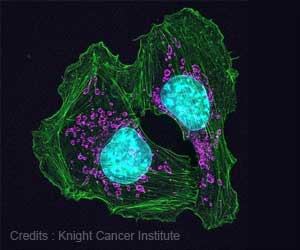[ad_1]

-
Molecular jackhammers – amino cyanine molecules stimulated by near-infrared light to rupture cancer cells’ membranes holds a remarkable 99 percent efficiency - Operating over a million times faster than previous nanoscale drills, these molecules represent a new frontier in cancer eradication
- The study’s unique application of molecular plasmons and the untapped potential of amino cyanine molecules offer a promising leap in cancer research
In a groundbreaking discovery, Rice University scientists have unlocked the potential to obliterate cancer cells through the ‘good vibrations’ of molecules stimulated by light, marking a paradigm shift in cancer treatment.
Researchers have harnessed the vibration power of certain molecules, induced by near-infrared light, to disrupt and rupture the cell membranes of cancer cells, providing an innovative approach to cancer treatment.
Advertisement
Molecular Jackhammers: A New Frontier in Cancer Eradication
The research team at Rice University, led by chemist James Tour, identified that atoms within a specific dye molecule used for medical imaging can vibrate collectively, forming a plasmon, when exposed to near-infrared light. This phenomenon acts as a molecular jackhammer, causing the cell membranes of cancerous cells to rupture. With an impressive 99 percent efficiency in lab cultures of human melanoma cells, this discovery showcases a promising avenue for cancer treatment.
Unlike previous nanoscale drills, these molecular jackhammers operate at a remarkable speed—more than one million times faster than their predecessors. Furthermore, their activation with near-infrared light, which penetrates up to 10 centimeters into the human body, surpasses the limitations of visible light, enhancing the depth of penetration without causing tissue damage. This unparalleled speed and mechanism mark a significant advance in cancer treatment methodologies.
Advertisement
Aminocyanine Molecules: The Biocompatible Heroes
The molecular jackhammers in question are aminocyanine molecules, a class of fluorescent synthetic dyes commonly used for medical imaging. Despite their simplicity and longstanding use, these molecules possess the unique ability to attach themselves to the fatty outer lining of cells, making them biocompatible and stable in water. This newfound application of aminocyanine molecules as plasmons showcases their untapped potential.
Lead author Ciceron Ayala-Orozco emphasizes that this study unveils a different approach to treating cancer. By utilizing molecular forces at the smallest scale, the researchers achieved the mechanical action needed to tear apart cancer cells’ membranes. This novel application of molecular plasmons, exhibiting near-symmetrical structures with anchor-like arms, sets the stage for a transformative shift in cancer therapeutics.
Advertisement
Photodynamic and Photothermal Therapy
The study clarifies that the molecular jackhammers’ mode of action defies categorization as photodynamic or photothermal therapy. This groundbreaking discovery introduces a new explanation for how molecules can work, demonstrating the first instance of a molecular plasmon being employed to excite the entire molecule, leading to mechanical action for a specific purpose—tearing apart cancer cells’ membranes.
Collaborating with researchers at Texas A&M University and the University of Texas MD Anderson Cancer Center, the study involved comprehensive analysis and cancer studies in mice.
Supported by Nanorobotics, Ltd., the Discovery Institute, and the Welch Foundation, this research paves the way for future developments in cancer treatment.
The discovery of light-induced whole-molecule vibrations as a potent tool against cancer cells signifies a significant breakthrough in cancer research. As scientists continue to explore and refine this approach, the future holds the promise of a new era in cancer treatment, offering hope for enhanced efficacy and reduced side effects. This groundbreaking research not only adds a new chapter to the understanding of cancer biology but also opens doors to innovative therapeutic interventions.
Reference:
- Molecular jackhammers eradicate cancer cells by vibronic-driven action – (https://www.nature.com/articles/s41557-023-01383-y)
Source-Medindia
[ad_2]
Source link